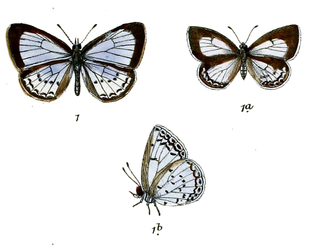Celastrina albocoeruleus, the albocerulean, is a small butterfly found in India that belongs to the lycaenids or blues family.

Celastrina iynteana, the Jyntea hedge blue, is a small butterfly found in India that belongs to the lycaenids or blues family.

Urodidae, whose species are commonly known as false burnet moths, is a family of moths in the lepidopteran order. It is the type genus in the superfamily, Urodoidea, with three genera, one of which, Wockia, occurs in Europe.

Sematurinae is a subfamily of moths in the family Sematuridae represented by at least 29 species in the Neotropics.

Hasora khoda, the large banded awl, is a butterfly belonging to the family Hesperiidae which is found in India, parts of Southeast Asia and Australia.
Aemilia castanea is a moth of the family Erebidae. It was described by James John Joicey and George Talbot in 1916. It is found in Ecuador.
Aemilia tabaconas is a moth of the family Erebidae. It was described by James John Joicey and George Talbot in 1916. It is found in Peru.
Pseudosphenoptera chimaera is a moth in the subfamily Arctiinae. It is found in Peru.

Ratarda excellens is a moth in the family Cossidae. It is found in Taiwan.
Polyphagozerra reticulata is a moth in the family Cossidae. It was described by James John Joicey and George Talbot in 1916. It is found on New Guinea and the Moluccas.
Elachista antipetra is a moth in the family Elachistidae. It was described by Edward Meyrick in 1922. It is found in India.
Picrodoxa is a monotypic genus of moths in the family Epermeniidae. The only species in the genus, Picrodoxa harpodes, is found in India. Both the genus and species were first described by Edward Meyrick in 1923.
Epermenia phorticopa is a moth in the family Epermeniidae. It was described by Edward Meyrick in 1921. It is found in India.
Stenoglene pellucida is a moth in the family Eupterotidae. It was described by James John Joicey and George Talbot in 1924. It is found in Cameroon and the Democratic Republic of the Congo (Orientale).
Papuapterote crenulata is a moth in the family Eupterotidae. It was described by James John Joicey and George Talbot in 1916. It is found on New Guinea.
Papuapterote punctata is a moth in the family Eupterotidae. It was described by James John Joicey and George Talbot in 1916. It is found on New Guinea.

The genus Mania comprises a group of tropical and semi-tropical New World moths in the family Sematuridae. The genus has historically been referred to as either Nothus or Sematura, but both of these names are invalid.
Pedoptila nigrocristata is a moth in the Himantopteridae family. It was described by James John Joicey and George Talbot in 1921. It is found in Zambia.
Semioptila lufirensis is a moth in the Himantopteridae family. It was described by James John Joicey and George Talbot in 1921. It is found in Katanga Province in the Democratic Republic of the Congo.




